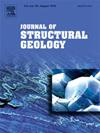A catalogue of calcite vein types in porous sandstone and their formation conditions (Huab Basin, Namibia)
IF 2.9
2区 地球科学
Q2 GEOSCIENCES, MULTIDISCIPLINARY
引用次数: 0
Abstract
We present a catalogue of calcite vein types in porous sandstone that have the potential to affect fluid flow properties in a reservoir. Host rock is the Lower Cretaceous aeolian Twyfelfontein Formation, covered by voluminous flood volcanic rock of the Paraná-Etendeka Large Igneous Province in the Huab Basin of NW Namibia. Since the host sandstone lacks carbonate components, these veins document advective fluid flow, where solutes were transported through the fractures from an external source. Crystal growth in veins vary from blocky, to radial, and micritic. Some veins exhibit an intergrowth with kaolinite, or show an initial dolomite and iron oxide precipitation. Deformation stages are evident in a number of veins from breccia to cataclasis and fault-slip slickenfibre generations. Some calcite generations underwent partial dissolution and replacement by chalcedony. U-Pb dating shows a predominant vein formation from 31 Ma to recent, with one outlier at ∼65 Ma. Pore-filling calcite cements of sandstone along veins and in contact with the covering volcanic rock show similar ages. Formation temperatures (16–47 °C) derived from clumped isotope analysis indicate precipitation at shallow burial depths (<1 km). An outlier of 59 °C stems from the vein dated to ∼65 Ma. Carbonate δ13CVPDB shows a trend from −8.3 ‰ to −1.3 ‰ between Oligocene to present and we argue this to be a reflection of the region's climatic shift from warm humid to (semi-)arid conditions in this time. We further discuss, that this shift is responsible for many of the observed vein characteristics.
纳米比亚Huab盆地多孔砂岩方解石脉类型及其形成条件
我们提出了多孔砂岩中方解石脉类型的目录,这些方解石脉类型有可能影响储层中的流体流动特性。寄主岩为下白垩统风成Twyfelfontein组,被纳米比亚西北部Huab盆地Paraná-Etendeka大火成岩省的大量洪水火山岩覆盖。由于寄主砂岩缺乏碳酸盐成分,这些矿脉记录了流体的平流流动,溶质从外部来源通过裂缝输送。晶脉中的晶体生长从块状、放射状和微晶状不等。有些矿脉与高岭石共生,或显示白云石和氧化铁的初始沉淀。从角砾岩到碎裂岩和断滑滑脱纤维几代,许多矿脉的变形阶段都很明显。一些方解石发生了部分溶解并被玉髓取代。U-Pb测年显示,从31 Ma到最近,主要是静脉形成,在~ 65 Ma有一个异常值。砂岩沿脉状充填孔隙的方解石胶结物与覆盖的火山岩的接触年龄相近。团块同位素分析得出的地层温度(16-47°C)表明埋藏深度较浅(1 km)有降水。59°C的异常值来自年龄为~ 65 Ma的静脉。从渐新世至今,碳酸盐岩δ13CVPDB的变化趋势为- 8.3‰~ - 1.3‰,反映了该区气候从暖湿向(半)干旱的转变。我们进一步讨论,这种转变是负责许多观察到的静脉特征。
本文章由计算机程序翻译,如有差异,请以英文原文为准。
求助全文
约1分钟内获得全文
求助全文
来源期刊

Journal of Structural Geology
地学-地球科学综合
CiteScore
6.00
自引率
19.40%
发文量
192
审稿时长
15.7 weeks
期刊介绍:
The Journal of Structural Geology publishes process-oriented investigations about structural geology using appropriate combinations of analog and digital field data, seismic reflection data, satellite-derived data, geometric analysis, kinematic analysis, laboratory experiments, computer visualizations, and analogue or numerical modelling on all scales. Contributions are encouraged to draw perspectives from rheology, rock mechanics, geophysics,metamorphism, sedimentology, petroleum geology, economic geology, geodynamics, planetary geology, tectonics and neotectonics to provide a more powerful understanding of deformation processes and systems. Given the visual nature of the discipline, supplementary materials that portray the data and analysis in 3-D or quasi 3-D manners, including the use of videos, and/or graphical abstracts can significantly strengthen the impact of contributions.
 求助内容:
求助内容: 应助结果提醒方式:
应助结果提醒方式:


